You are using an out of date browser. It may not display this or other websites correctly.
You should upgrade or use an alternative browser.
You should upgrade or use an alternative browser.
More Regner Else and no water
- Thread starter Fred2179G
- Start date
Fred2179G
Registered
Many thinks for your suggestions. They saved a lot of time and thought!Time for an air test with the reverser valve assembled, of course.
Next remove the rotary slider of the reverser valve. Blow air through each of the four passages.

So here I am blowing through the 4 passages. they are: steam from boiler; exhaust to stack/chimney; feed to outer end of valves; and feed to inner end of valves.
With the safety out, there was no problem blowing all 4 - the boiler steam feed blow resulted in all the water in the boiler spraying out, fortunately on the towel. (A lot of white powder came out too - lime, I guess.) Blowing in to the cylinder exhaust vent sounded different from blowing in the steam feed, but it probably should.There should be no blockage, but one which is the lead from the boiler. Or the obstacle gets blown out.
So I reassembled the rotary valve and put my air feed in the boiler safety plug. The compressor would get it up to 4 bar before I opened the throttle, and it appeared that air was coming out of both ends of the valve port cylinder/tubes.
Then I put back the valves and checked the timing, put the loco on the rollers and opened the throttle at 4 bar. Still no movement. This is getting weird.
My final test was to leave the compressor running and to turn the wheels, listening to the exhaust beat. I could just distinguish 4 events per revolution, which is correct. They weren't all identical but they seldom are, in my experience.
Interesting statement - and true with the valves out. However, on my other locos (except Stanley, which is so worn it will roll downhill on the slightest slope,) they don't roll and you can usually feel a little compression as the pistons move backward and forward. Pushing this loco on the track does not show any resistance at all - pretty much like my Stanley!Moving the piston either way you should not feel much of resistance. If you experience compression
If the pistons have no teflon seals, the steam will leak around them and there won't be any movement. Going back to my earlier observation, that the loco spins 3/4 of a turn and stops with on piston halfway - this pic was when it was in steam and stopped - which is most unusual for a steam engine.
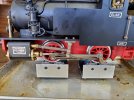
So I am left to wonder if that piston is leaking and not providing movement. Shouldn't be a big deal to take the end off and have a look.
ol_hogger
Registered
Hm, puzzling. The piston arrested midway ... does not sound like a leak. Can you hear a hiss at that point?
The piston test was intended with valve chests empty so as to make sure the cylinder ports are free. I am not sure whether you have described the result.
The (almost) all teflon valves should drop right in. Center position adjustment may be different, with the front end spindle nut that holds everthing together. Make a side by side conparison to be sure.
The piston test was intended with valve chests empty so as to make sure the cylinder ports are free. I am not sure whether you have described the result.
The (almost) all teflon valves should drop right in. Center position adjustment may be different, with the front end spindle nut that holds everthing together. Make a side by side conparison to be sure.
Fred2179G
Registered
I don't think that's what is happening. When the motion stops, the other side piston is at full extension (fully forward or fully back.) You'd expect this piston to take up the motion as it is in the center - in fact, it should have been helping.The piston arrested midway ... does not sound like a leak
If there is no teflon seal around the piston, then incoming steam would just move past the piston and exit with the exhaust - no work done. That's what I meant by a leak - from one side of the piston to the other. If that is what is going on, then it would explain why it stops at 90 degrees, bottom-dead-center, as that's when any push from the other side is totally dissipated.
It won't take a minute to pull the piston out on that side. Stay tuned. . .
I did move the wheels with the valve chests empty. This loco rolls freely whatever state the valves are in.The piston test was intended with valve chests empty
A suggestion from someone who knows nothing:
You said "white powder" came out, at one point?
Could there be a build-up of this, in one cylinder, just before the end of the stroke?
Cold, there may be enough clearance, for the motion to run, but once warm and wet, things are binding, and stopping it running.
Please feel free to ignore this..
PhilP.
You said "white powder" came out, at one point?
Could there be a build-up of this, in one cylinder, just before the end of the stroke?
Cold, there may be enough clearance, for the motion to run, but once warm and wet, things are binding, and stopping it running.
Please feel free to ignore this..
PhilP.
Fred2179G
Registered
Phil, your suggestions are always appreciated. However, if the powder was in a cylinder then 2 things: (1) the piston stopped in mid-stroke, not at the end, and (2) there would be some residue blown out of the stack/chimney and you'd see it - especially against a black loco.You said "white powder"
Fred2179G
Registered
Well, here's surprise. All Teflon!So let's look at the piston.
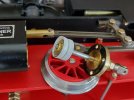
To back up a minute - it took a bit more than 5 minutes to get it out. There's a bolt right in back behind the wheel. Very slow to remove when all you can do is turn it 1 flat at a time with a spanner. (I shortened it a little to reduce the work putting it back. Probably not the right idea, as the threads hold the cover against the steam pressure.) Note the rotary valve is in neutral.
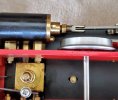
You can also see that the gland nut sealing the end of the cylinder around the piston rod is close to the clevis. This pic shows it when the motion is back together. The clevis was contacting the gland nut so I tightened the nut to the point that the piston rod was stiff, then I released it a bit. Possibly ruined the seal - but there's plenty more teflon tape in my toolbox.
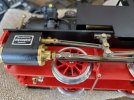
While the piston was out, I fired up the compressor and I could clearly hear and feel the air blowing out of the cylinder as I turned the wheels and moved the valve piston, twice per revolution, which is as expected.
However, with the rod disconnected and the rotary valve in neutral, I moved the piston back and forward, hoping to feel some resistance. Zilch. Maybe it does need a little teflon tape in the teflon piston.
Finally, with it all back together, I cranked up the compressor and ran it up to 4 bar on the gauge. Opening the throttle after I put it in forward gear produced nothin'. Nada. The wheels don't even seem to want to try to move on air. (The whistle sounds great though!) I could push the wheels round backwards or forwards - though it preferred forwards.
All I can think of is to try teflon on the piston until it feels like there is some pressure resistance, as there is none at the moment.
S
siclick33
Guest
I'm very new to this but I do have experience with trying to locate air leaks past cylinders.
You say that you could feel air blowing out of the cylinder as you turn it. What happens if the piston is stationary? Can you still feel air coming out of the exhaust? That might indicate whether the piston is sealed in the cylinder or not.
Sorry if that's a silly question.
You say that you could feel air blowing out of the cylinder as you turn it. What happens if the piston is stationary? Can you still feel air coming out of the exhaust? That might indicate whether the piston is sealed in the cylinder or not.
Sorry if that's a silly question.
Fred2179G
Registered
There are no silly questions.Sorry if that's a silly question.
I checked that there was air coming from the cylinder when the piston was out - to confirm that both ends were getting air from the boiler via the valves and that there isn't a blockage.
It's pretty clear the pistons are not sealed in the cylinders, though if you read back a few posts, you'll find I noted that there are 4 exhaust events per revolution, so the valves are working. In my experience, if you push a steam engine with the gear in neutral, there will be some resistance as the pistons move. Not this engine! I also removed the rod and pushed the piston by hand, with no sign of resistance.
Fred2179G
Registered
Yes, well, the Johnson Bar which I am more familiar with has a forward-neutral-reverse positioning. It's probablty US terminology. [I was a Brit once, so I am somewhat sensitive to these things.] Most 'neutral' positions stopped the loco dead in its tracks- my C-19 needed neutral on hills, as it just coasted if you shut the throttle and actually gained speed downhill! (Not this loco though.)refer to as "neutral" actually is "shut off"
I wonder if there is anywhere on the pistons that may take an ‘O’ ring or some packing? I think you have referred to this already. It certainly appears that the pistons are not doing any job in the bore. To work of course you need some compression for the steam to do its job and to my mind and I think you as well that is not occurring.There are no silly questions.
I checked that there was air coming from the cylinder when the piston was out - to confirm that both ends were getting air from the boiler via the valves and that there isn't a blockage.
It's pretty clear the pistons are not sealed in the cylinders, though if you read back a few posts, you'll find I noted that there are 4 exhaust events per revolution, so the valves are working. In my experience, if you push a steam engine with the gear in neutral, there will be some resistance as the pistons move. Not this engine! I also removed the rod and pushed the piston by hand, with no sign of resistance.
Fred2179G
Registered
Well, that is certainly the next step.if there is anywhere on the pistons that may take an ‘O’ ring or some packing?
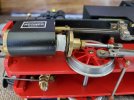
With a loop of teflon around the piston, it certainly seemed to make a better seal.
I did get an interesting answer from the UK Distributor:
"It looks like you are concerned that the pistons may be leaking steam past. if that's the case then maybe you could try this: When you reassemble the pistons I would smear a film of Regner steam oil in the cylinders and over the teflon pistons. You have probably realised Regner steam oil is like treacle and it sticks to everything. Believe it or not it actually helps create a seal.
You may have also noticed the inside of the cylinder is not polished perfectly smooth they are honed with a very fine cross pattern. The reason for the honing is to hold a film of the thick steam oil (using a thinner grade will not give you this). The pistons are practically running on a film of oil which also means less wear.
The teflon cup pistons have been around for some time so those pistons are probably the original ones that came with the loco."
Well, I don't have any treacly Regner steam oil, but I can certainly try my regular steam oil; I may even have some Roundhouse oil too.
Anyway, I decided to try another steam test, as there are suggestions that the teflon expands a little with heat and water. This time I even took a little video. You can see it is trying to spin its wheels.
It is noticeable that the wheels jerk rapidly through 90 degrees. Then, with one piston at the end of its stroke and the other in the center, it stops. This time it happens on both sides - before I 'improved' the port side (LH looking forward) it only happened when the RH side was fully extended.
If the piston is in the center and is getting steam it should be providing the bulk of the push to rotate the wheels.
The steam pressure stays down at 1+ bar once the throttle is open. There is some steam escaping from underneath - I suspect the reversing valve could by smoother and therefore more steam tight.
Last edited:
Fred2179G
Registered
Phil, I am using steam oil. Now it has cooled down I will be checking the lubricator to see how much it used. My comments were that Regner seems to have special treacle oil, which I wasn't even aware of.I would definitely try the correct grade of steam oil,

